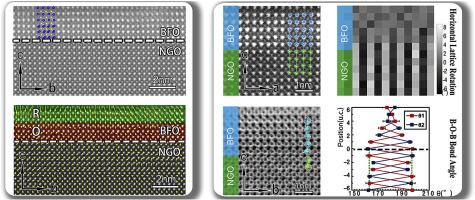当前位置:
X-MOL 学术
›
Acta Mater.
›
论文详情
Our official English website, www.x-mol.net, welcomes your
feedback! (Note: you will need to create a separate account there.)
Coexistence of rhombohedral and orthorhombic phases in ultrathin BiFeO 3 films driven by interfacial oxygen octahedral coupling
Acta Materialia ( IF 8.3 ) Pub Date : 2018-02-01 , DOI: 10.1016/j.actamat.2017.12.038 M.J. Han , Y.J. Wang , D.S. Ma , Y.L. Zhu , Y.L. Tang , Y. Liu , N.B. Zhang , J.Y. Ma , X.L. Ma
Acta Materialia ( IF 8.3 ) Pub Date : 2018-02-01 , DOI: 10.1016/j.actamat.2017.12.038 M.J. Han , Y.J. Wang , D.S. Ma , Y.L. Zhu , Y.L. Tang , Y. Liu , N.B. Zhang , J.Y. Ma , X.L. Ma

|
Abstract Coexistence of two phases creates a morphotropic phase boundary in perovskite oxides, which can provide large piezoelectric response, generating it a well suited system for probe-based memories and actuator applications. The coexistence of two phases in thin films is proposed to be induced by epitaxial constraints from substrates or chemical compositional modifications by substitution. In this work, we found a new formation mechanism of two-phase coexistence driven by interfacial oxygen octahedral coupling (OOC) in oxide heterostructures. We fabricated a series of BiFeO 3 (BFO) ultrathin films on various orthorhombic substrates exerting from tensile to compressive strains by Pulsed Laser Deposition (PLD) techniques. Aberration-corrected transmission electron microscopy demonstrates that the lattice rotation and oxygen octahedral rotation (OOR) patterns transfer from these substrates to BFO films in about 3 unit cells while an orthorhombic ( Pnma ) phase forms at the interface due to OOC. This Pnma phase is non-polar, which differs from polar phases of Ima2 or Pmc2 1 when a large tensile strain is imposed onto BFO. First-principles calculations reproduce these experimental results perfectly. This phase transition occurs when BFO films are under both tensile and compressive strains suggesting that OOC alone can induce phase transition in ultrathin BFO films. Such coexistence of two phases may have many potential applications in the field of electronics, such as ferroelectric sensors and actuators.
中文翻译:

界面氧八面体耦合驱动的超薄BiFeO 3 薄膜中菱形相和正交相的共存
摘要 两相的共存在钙钛矿氧化物中产生了同形相界,它可以提供大的压电响应,使其成为非常适合基于探针的存储器和致动器应用的系统。薄膜中两相的共存被认为是由衬底的外延约束或通过取代的化学成分改变引起的。在这项工作中,我们发现了一种由氧化物异质结构中的界面氧八面体耦合(OOC)驱动的两相共存的新形成机制。我们通过脉冲激光沉积 (PLD) 技术在从拉伸应变到压缩应变的各种正交基底上制造了一系列 BiFeO 3 (BFO) 超薄膜。像差校正透射电子显微镜表明,晶格旋转和氧八面体旋转 (OOR) 模式从这些基板转移到大约 3 个晶胞中的 BFO 膜,而由于 OOC 在界面处形成正交 (Pnma) 相。该 Pnma 相是非极性的,当对 BFO 施加大的拉伸应变时,它不同于 Ima2 或 Pmc2 1 的极性相。第一性原理计算完美地再现了这些实验结果。当 BFO 薄膜同时处于拉伸和压缩应变下时,就会发生这种相变,这表明单独的 OOC 可以在超薄 BFO 薄膜中引起相变。这种两相的共存可能在电子领域具有许多潜在的应用,例如铁电传感器和执行器。
更新日期:2018-02-01
中文翻译:

界面氧八面体耦合驱动的超薄BiFeO 3 薄膜中菱形相和正交相的共存
摘要 两相的共存在钙钛矿氧化物中产生了同形相界,它可以提供大的压电响应,使其成为非常适合基于探针的存储器和致动器应用的系统。薄膜中两相的共存被认为是由衬底的外延约束或通过取代的化学成分改变引起的。在这项工作中,我们发现了一种由氧化物异质结构中的界面氧八面体耦合(OOC)驱动的两相共存的新形成机制。我们通过脉冲激光沉积 (PLD) 技术在从拉伸应变到压缩应变的各种正交基底上制造了一系列 BiFeO 3 (BFO) 超薄膜。像差校正透射电子显微镜表明,晶格旋转和氧八面体旋转 (OOR) 模式从这些基板转移到大约 3 个晶胞中的 BFO 膜,而由于 OOC 在界面处形成正交 (Pnma) 相。该 Pnma 相是非极性的,当对 BFO 施加大的拉伸应变时,它不同于 Ima2 或 Pmc2 1 的极性相。第一性原理计算完美地再现了这些实验结果。当 BFO 薄膜同时处于拉伸和压缩应变下时,就会发生这种相变,这表明单独的 OOC 可以在超薄 BFO 薄膜中引起相变。这种两相的共存可能在电子领域具有许多潜在的应用,例如铁电传感器和执行器。











































 京公网安备 11010802027423号
京公网安备 11010802027423号